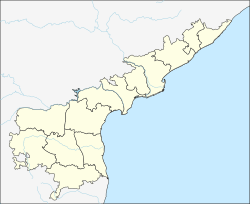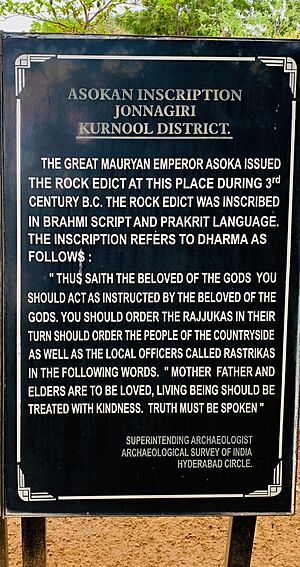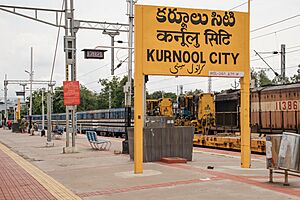Kurnool facts for kids
Quick facts for kids
Kurnool
Kandanavōlu (Kandanōlu)
|
|
|---|---|
|
City
|
|
|
Clockwise from top: Skyline of Kurnool from Penna River Bridge, Pumphouse road in Kurnool, Kurnool Railway station, Kurnool City from Jagannatha Gattu and Kondareddy Buruju
|
|
| Nickname(s):
The Gateway of Rayalaseema
|
|
| Country | |
| State | Andhra Pradesh |
| Region | Rayalaseema |
| District | Kurnool |
| Government | |
| • Type | Municipal corporation |
| • Body | Kurnool Municipal Corporation |
| Area | |
| • City | 129.2 km2 (49.9 sq mi) |
| Area rank | 107 |
| Elevation | 274 m (899 ft) |
| Population
(2011)
|
|
| • City | 425,214 |
| • Rank | 109th (India) 5th (Andhra Pradesh) |
| • Density | 3,291.1/km2 (8,524/sq mi) |
| • Metro | 484,327 |
| Demonym(s) | Kurnoolian |
| Languages | |
| • Official | Telugu |
| Time zone | UTC+5:30 (IST) |
| PIN |
518001, 518002, 518003, 518004, 518005, 518006, 518007
|
| Vehicle registration | AP-21 |
Kurnool is a city in the state of Andhra Pradesh, India. It was once the capital of Andhra State from 1953 to 1956. People often call Kurnool "The Gateway of Rayalaseema" because of its location.
Kurnool is also known for diamond hunting. After heavy monsoon rains wash away the top soil, diamonds can sometimes be found in the barren land. The city is the main office for the Kurnool district. In 2011, Kurnool was the fifth largest city in Andhra Pradesh, with a population of 484,327 people. It is located on the banks of the Tungabhadra River. Even though people have lived in this area for thousands of years, the modern city of Kurnool started in the 16th century when the Konda Reddy Fort was built.
Contents
What Does the Name Kurnool Mean?
The old name for Kurnool in historical records was Kandanavōlu or Kandanōlu. It was a place where people crossed the Tungabhadra River. It is believed that bullock cart drivers would grease their wheels here. The word "kandana" refers to grease.
A Look at Kurnool's Past
Ancient Times: Palaeolithic Era
Some of the oldest rock paintings from the Palaeolithic era are found near Kurnool. These paintings are about 18 kilometers away at Ketavaram. Other important rock art sites like Jurreru Valley and Yaganti in Kurnool District might be 35,000 to 40,000 years old.
In the 3rd century BCE, Ashoka's rock edicts were carved here. These are ancient messages written in the Prakrit language using the Brahmi script. Both major and minor edicts are found at Erragudi, also called Yerragudi. These are some of the oldest writings found in India. The site is protected by the Archaeological Survey of India (ASI).
The Belum Caves in the district are very important geologically and historically. It seems that Jain and Buddhist monks lived in these caves many centuries ago. Many Buddhist items were found inside the caves. These items are now kept in a museum in Ananthapur. The Archaeological Survey of India found pieces of old pots and other items. They believe these items are from around 4500 BC, even before the time of Buddhism.
Rule by Different Empires
Not much was known about Kurnool before the 11th century. The earliest records show it was a stopping point on the southern banks of the Tungabhadra River.
In the 12th century, the Cholas ruled Kurnool. Later, in the 13th century, the Kakatiya dynasty took over. Kurnool grew as a transit spot on the Tungabhadra River. Eventually, it became part of the powerful Vijayanagara Empire. Achyuta Deva Raya, who followed Sri Krishnadeva Raya, built the Kurnool Fort in the 16th century.
Mughal and Nawab Rule
In the 17th century, Abdul Wahab Khan, from Abyssinia, defeated King Gopal Raja of the Vijayanagar Kingdom. He ruled Kurnool for 16 years.
In 1686, Kurnool came under the control of the Mughal Empire, led by Emperor Aurangzeb. Later, the Nawabs ruled Kurnool until the British Government took control in 1839.
Ghulam Rasul Khan Bahadur was the last Nawab of Kurnool. He ruled from 1823 to 1839. In October 1839, a war started between the British Indian Army and the kingdom. After six days, the king was captured. He was sent to prison in Tiruchirappalli and died there in 1840.
Kurnool After India's Independence
Kurnool was the capital of the old Andhra State from October 1, 1953, to October 31, 1956. This state later joined with the Telugu-speaking parts of Hyderabad State to form Andhra Pradesh. Hyderabad became the new capital on November 1, 1956. Today, Kurnool is part of the current state of Andhra Pradesh.
Kurnool's Location and Environment
Where is Kurnool Located?
Kurnool is located at 15°50′00″N 78°03′00″E / 15.8333°N 78.05°E. It is about 273 meters (898 feet) above sea level. The city is on the banks of the Tungabhadra River. The Hundri and Neeva rivers also flow through Kurnool. The K. C. Canal (Kurnool–Cuddapah) was first built by the Dutch for transport. Now, it is used for watering farms.
Famous Places in Kurnool
Some important places in and around Kurnool include the Konda Reddy Fort. This historical monument, also called Kondareddy Burj, is a major tourist spot in the city. The Orvakal Rock Gardens is a sculpture garden with an ancient cave. It is located southeast of the city. The Jagannatha Gattu Temple is another popular place to visit. It is famous for its Lord Shiva Temple in B. Thandrapadu. The story behind the Linga (a symbol of Lord Shiva) makes it a special destination.
Kurnool's Climate
Kurnool has a hot, dry climate. Temperatures can go from 26°C to 46°C (79°F to 115°F) in summer. In winter, temperatures range from 12°C to 31°C (54°F to 88°F). The city gets about 720 millimeters (28 inches) of rain each year.
| Climate data for Kurnool (1981–2010, extremes 1901–2012) | |||||||||||||
|---|---|---|---|---|---|---|---|---|---|---|---|---|---|
| Month | Jan | Feb | Mar | Apr | May | Jun | Jul | Aug | Sep | Oct | Nov | Dec | Year |
| Record high °C (°F) | 37.3 (99.1) |
39.9 (103.8) |
43.3 (109.9) |
44.8 (112.6) |
45.6 (114.1) |
45.6 (114.1) |
38.5 (101.3) |
37.8 (100.0) |
38.7 (101.7) |
38.4 (101.1) |
38.8 (101.8) |
35.4 (95.7) |
45.6 (114.1) |
| Mean daily maximum °C (°F) | 31.7 (89.1) |
34.8 (94.6) |
38.2 (100.8) |
40.1 (104.2) |
40.5 (104.9) |
36.2 (97.2) |
33.6 (92.5) |
32.5 (90.5) |
32.9 (91.2) |
32.5 (90.5) |
31.2 (88.2) |
30.5 (86.9) |
34.6 (94.3) |
| Mean daily minimum °C (°F) | 17.9 (64.2) |
20.3 (68.5) |
23.8 (74.8) |
26.7 (80.1) |
27.5 (81.5) |
25.5 (77.9) |
24.5 (76.1) |
23.9 (75.0) |
23.8 (74.8) |
22.8 (73.0) |
20.1 (68.2) |
17.8 (64.0) |
22.9 (73.2) |
| Record low °C (°F) | 8.3 (46.9) |
11.1 (52.0) |
12.8 (55.0) |
15.5 (59.9) |
19.4 (66.9) |
17.6 (63.7) |
19.2 (66.6) |
19.9 (67.8) |
17.0 (62.6) |
13.0 (55.4) |
9.3 (48.7) |
6.7 (44.1) |
6.7 (44.1) |
| Average rainfall mm (inches) | 4.0 (0.16) |
2.2 (0.09) |
9.8 (0.39) |
26.4 (1.04) |
50.4 (1.98) |
93.6 (3.69) |
121.4 (4.78) |
143.4 (5.65) |
145.0 (5.71) |
114.1 (4.49) |
23.0 (0.91) |
3.9 (0.15) |
737.2 (29.02) |
| Average rainy days | 0.3 | 0.2 | 0.7 | 1.6 | 2.7 | 5.7 | 7.6 | 9.0 | 7.7 | 5.2 | 1.9 | 0.3 | 43.0 |
| Average relative humidity (%) (at 17:30 IST) | 35 | 26 | 23 | 25 | 28 | 45 | 54 | 57 | 57 | 56 | 51 | 44 | 42 |
| Source: India Meteorological Department | |||||||||||||
Kurnool has been recognized as the 21st best "National Clean Air City" in India. This ranking is for cities with populations between 300,000 and 1 million people.
People and Languages of Kurnool
How Many People Live in Kurnool?
In 2011, the Kurnool urban area had a population of 484,327. This made it the fifth largest city in Andhra Pradesh. The literacy rate in Kurnool was 77.37 percent in 2011. This means that most people in the city can read and write.
| Literacy in Kurnool | ||||
|---|---|---|---|---|
| All | 77.37% | |||
| Male | 83.01% | |||
| Female | 71.24% | |||
Religions in Kurnool
| Religions in Kurnool city (2011) | ||||
|---|---|---|---|---|
| Religion | Percent | |||
| Hinduism | 67.20% | |||
| Islam | 29.20% | |||
| Christianity | 2.50% | |||
| Other or not stated | 1.10% | |||
| Distribution of religions | ||||
According to the 2011 census, most people in Kurnool are Hindus. Other groups living in Kurnool include Muslims, Christians, and Jains.
Languages Spoken in Kurnool
Telugu is the main and official language spoken in Kurnool. About 67.91% of people speak Telugu. Urdu is also widely spoken by 28.17% of the population. A smaller number of people, about 1.02%, speak Hindi.
Learning and Education in Kurnool
Schools in Kurnool are run by the Government, private organizations, and aided by the state's School Education Department.
Some important colleges and universities in the city are:
- Dr. Abdul Haq Urdu University
- G Pulla Reddy College of Engineering & Technology
- Indian Institute of Information Technology, Design and Manufacturing, Kurnool
- Kurnool Medical College
- Osmania College, Kurnool
- Rayalaseema University
- Silver Jubilee Government Degree College
Getting Around Kurnool
Roads and Highways
Several major highways pass through Kurnool. National Highway 44 (India) connects Srinagar in the north to Kanyakumari in the south. It also links Bangalore to Hyderabad.
National Highway 340C goes from Kurnool to Dornala. This road connects to places like Srisailam, Vinukonda, Guntur, and Vijayawada.
National Highway 40, also known as the Rayalaseema Expressway, runs from Kurnool to Chittoor.
The Surat–Chennai Expressway is currently being built and will also pass near the city. Kurnool has a total road length of 519.22 kilometers. The state bus system, APSRTC, operates buses from Kurnool bus station to other parts of Andhra Pradesh.
Trains and Railways
The Kurnool City railway station is on the railway line that connects Bengaluru and Hyderabad. It is an important "A–category station" in the Hyderabad railway division. There is another railway station called Kotla located in the middle of the city.
Kurnool Airport
Kurnool Airport, officially named Uyyalawada Narasimha Reddy Airport, is located at Orvakal. It is on National Highway 40, about 18 kilometers from Kurnool. This new airport started commercial flights in March 2021.
Kurnool's Economy
The total economic output (GDP) of Kurnool City is about $3.266 billion.
Kurnool has many valuable mineral resources. Important minerals found here include iron ore, dolomite, limestone, ochre, quartz, and silica.
Famous People from Kurnool
- Abdul Hafeez Khan, a politician (MLA) from Kurnool
- K. E. Krishnamurthy, a former Deputy Chief Minister of Andhra Pradesh
- Arcot Ramasamy Mudaliar - Founder of the Justice party and the first President of UNESCO
- Kotla Jayasurya Prakasha Reddy, a former Member of Parliament and Union Minister for Railways
- Kotla Vijaya Bhaskara Reddy, a former Chief Minister of United Andhra Pradesh
- Damodaram Sanjivayya, a former Chief Minister of United Andhra Pradesh
- Machani Somappa, an industrialist who received the Padma Sri award
- T. G. Venkatesh, an Indian businessman and politician
See also
 In Spanish: Kurnool para niños
In Spanish: Kurnool para niños











